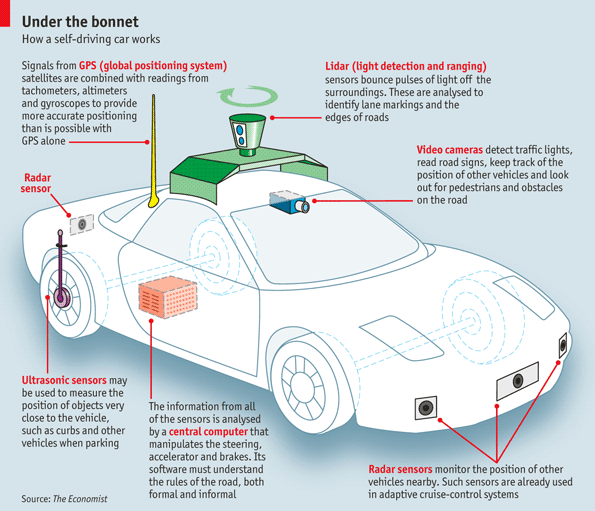Law issues regarding autonomous driving (CDIO #Assignment 5)
In this assignment we will further look
into the legal problems regarding autonomous driving and its application. As
the technology of AD vehicles develops extremely fast today, the build of legal
framework may not be able to catch up the speed and fully take care of the
newly technologies onto the market, and that’s where problems might happen.
After viewing several materials, I found
that the main ethic and legal problems can be summarized as following:
1.
Liability: Liability is
probably the most major ethical issue regarding autonomous vehicles. Who to
blame, and who should be responsible for accident if crash happens is always
the hot topic among several agencies: engineers, manufactures, salers, users,
pedestrians, governments or even law makers are all involved in this topic. If
any of these accidents happens, often it is unclear or hard to decide who to
blame.
2.
Society: Say, if large number
of AD vehicles are released and used in the traffic system, which would make
the whole transportation more intelligent and easy to control, it is for sure
that will lower the risk of car accidents. Because if the system is operating
as a whole, it is safer than individual drivers control their own cars.
However, this state is far from being realized, and during the process of
development, how to deal with the mixing issue of AD vehicles and non-AD
vehicles. For example, if most of the cars are already autonomous driving, then
is it proper to still allow manually driven cars on the road? Because in that
time, the AD driving mode could be largely different from manually driving.
3.
Conflict between fast developed
technologies and current laws: The AD technologies have been developing at a
speed that faster than the completion of laws, because new things come up
quickly but laws can take quite a long time to be established. Issues may
happen that new technologies cannot be restricted within the legal framework.
If that causes accidents, no law can explain the situation and the society
would be in chaos. I guess that’s why many states in America and other
countries are now clearly forbidding AD cars on the road. However, it is not
easy to solve this problem, and it may require efforts from both government
laws and manufacture regulations.
4.
Vulnerability of vehicle
systems: When engineers designed the complex functions of vehicle systems,
especially V2X wireless communication technologies, vulnerability of the system
has always been a problem when it comes to internet safety and privacy. The
complexity of autonomous vehicle computer systems can easily face the risk of
failure or other safety issues like being hacked. As shown in some science
fiction movies, it is not unrealistic to hack an intelligent vehicle and even
do criminal things. So when large number of vehicle are controlled within the
intelligent transportation systems, any single failure would cost a great loss.
5.
Difference in laws at different
districts or states: It is easy to design and manufacture a car, but when it is
sold in a certain district, laws always become the most complex things. Not to
mention the different laws and regulations between countries like EU and
America, even in different status in America, governments have different
requirements on vehicles.
6.
Unemployment: nowadays in large
cities still a great number of people make a living on driving, for example
taxi drivers, bus drivers and driving schools. If cars all become autonomous,
it may cause the job loss for many people.
7.
Trolley problem: problems also
happen within the autonomous driving vehicle decision systems, for example, the
trolley problem, Although Asimov’s famous three laws restricts the decision of
intelligent systems to protect human lives, when it comes to ethic situation,
even human is hard to make decision or say right or wrong sometimes, not to
mention programming the ethic into control system.


Comments
Post a Comment